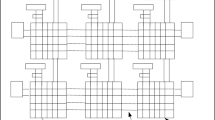Abstract
Hierarchical approaches address the complexity of test generation through symbolic reachability paths that provide access to the I/Os of each module in a design. However, while transparency behavior suitable for symbolic design traversal can be utilized for constructing reachability paths for datapath modules, control modules do not exhibit transparency. Therefore, incorporating such modules in reachability path construction requires exhaustive search algorithms or expensive DFT hardware. In this paper, we discuss a fast hierarchical test path construction method for circuits with DFT-free controller-datapath interface. A transparency-based RT-Level hierarchical test generation scheme is devised for the datapath, wherein locally generated vectors are translated into global design test. Additionally, the controller is examined through the introduced concept of influence tables, which are used to generate valid control state sequences for testing each module through hierarchical test paths. Fault coverage and vector count levels thus attained match closely those of traditional test generation methods, while sharply reducing the corresponding computational cost and test generation time.
Similar content being viewed by others
References
M.S. Abadir and M.A. Breuer, “A Knowledge-Based System for Designing Testable VLSI Chips,” IEEE Design and Test of Computers, vol. 2, no. 4, pp. 56–68, 1985.
P. Ashenden, The Designer's Guide to VHDL, San Matco, CA: Morgan-Kaufmann Publishers, 1996.
J.E. Carletta and C.A. Papachristou, “Behavioral Testability Insertion for Datapath/Controller Circuits,” Journal of Electronic Testing: Theory and Applications, vol. 11, no. 1, pp. 9–28, 1997.
S. Dey, V. Gangaram, and M. Potkonjak, “A Controller Redesign Technique to Enhance Testability of Controller-Datapath Circuits,” IEEE Transactions on Computer-Aided Design of Integrated Circuits and Systems, vol. 17, no. 2, pp. 157–168, 1998.
S. Freeman, “Test Generation for Data-Path Logic: The F-Path Method,” IEEE Journal of Solid-State Circuits, vol. 23, no. 2, pp. 421–427, 1988.
I. Ghosh, A. Ragunathan, and N.K. Jha, “A Design for Testability Technique forRTL Circuits Using Control/Data Flow Extraction,” IEEE Transactions on Computer-Aided Design of Integrated Circuits and Systems, vol. 17, no. 8, pp. 706–723, 1998.
J.P. Hayes, Computer Architecture and Organization, 3rd edn., New York: McGraw-Hill, 1998.
F.F. Hsu, E.M. Rudnick, and J.H. Patel, “Enhancing High-Level Control-Flow for Improved Testability,” in International Conference on Computer-Aided Design, 1996, pp. 322–328.
IEEE P1500 standard for embedded core test. Available from http://www.manta.ieee.org/groups/1500.
H.K. Lee and D.S. Ha, “HOPE: An Efficient Parallel Fault Simulator for Synchronous Sequential Circuits,” IEEE Transactions on Computer-Aided Design of Integrated Circuits and Systems, vol. 15, no. 9, pp. 1048–1058, 1996.
J. Lee and J.H. Patel, “Hierarchical Test Generation Under Architectural Level Functional Constraints,” IEEE Transactions on Computer-Aided Design of Integrated Circuits and Systems, vol. 15, no. 9, pp. 1144–1151, 1997.
Y. Makris, J. Collins, A. Orailoglu, and P. Vishakantaiah, “TRANSPARENT:ASystem forRTLTestability Analysis,DFT Guidance and Hierarchical Test Generation,” in Custom Integrated Circuits Conference, 1999, pp. 159–162.
Y. Makris and A. Orailoglu, “RTL Test Justification and Propagation Analysis for Modular Designs,” Journal of Electronic Testing: Theory and Applications, vol. 13, no. 2, pp. 105–120, 1998.
Y. Makris and A. Orailoglu, “DFT Guidance Through RTL Test Justification and Propagation Analysis,” in International Test Conference, 1998, pp. 668–677.
B.T. Murray and J.P. Hayes, “Hierarchical Test Generation Using Precomputed Tests for Modules,” IEEE Transactions on Computer Aided Design, vol. 9, no. 6, pp. 594–603, 1990.
B.T. Murray and J.P. Hayes, “Test Propagation Through Modules and Circuits,” in International Test Conference, 1991, pp. 748–757.
T. Niermann, W.T. Cheng, and J.H. Patel, “PROOFS: A Fast, Memory Efficient Sequential Circuit Fault Simulator,” in Design Automation Conference, 1990, pp. 535–540.
T. Niermann and J.H. Patel, “HITEC: A Test Generation Package for Sequential Circuits,” in European Conference on Design Automation, 1992, pp. 214–218.
P. Vishakantaiah, J.A. Abraham, and M.S. Abadir, “Automatic Test Knowledge Extraction from VHDL (ATKET),” in Design Automation Conference, 1992, pp. 273–278.
P. Vishakantaiah, J.A. Abraham, and D.G. Saab, “CHEETA: Composition of Hierarchical Sequential Tests Using ATKET,” in International Test Conference, 1993, pp. 606–615.
R.S. Tupuri and J.A. Abraham, “A Novel Test Generation Method for Processors Using Commercial ATPG,” in International Test Conference, 1997, pp. 743–752.
Y. Zorian, E.J. Marinissen, and S. Dey, “Testing Embedded-Core Based System Chips,” in International Test Conference, 1998, pp. 130–143.
Author information
Authors and Affiliations
Rights and permissions
About this article
Cite this article
Makris, Y., Collins, J. & Orailoğlu, A. Fast Hierarchical Test Path Construction for Circuits with DFT-Free Controller-Datapath Interface. Journal of Electronic Testing 18, 29–42 (2002). https://doi.org/10.1023/A:1013723905896
Issue Date:
DOI: https://doi.org/10.1023/A:1013723905896




